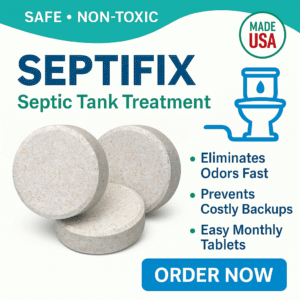Not sure if your septic tank is full? It’s a common worry for homeowners. A full or overloaded tank can cause slow drains, bad smells, or even messy backups. Knowing the signs early helps you avoid expensive repairs and keeps your system running smoothly. Here’s a complete guide to spotting the warning signals, plus some top tools and products that can make managing your septic tank easier.
Quick Picks
- RIDGID SeeSnake Inspection Camera – Best Overall: visually check your septic tank before calling a pumping service.
- Polylok Septic Tank Riser Kit – Best Budget: makes tank access simple for inspections and pumping.
- Liberty Pumps LE51A Sewage Pump – Best Premium: professional-grade sewage pump for heavy-duty septic systems.
Buyer’s Guide: Signs of a Full Septic Tank
Here are the most common indicators that it’s time to check your septic tank:
- Slow Drains: If sinks, showers, or toilets drain sluggishly, the tank could be full or your drainfield is struggling.
- Gurgling Sounds: Bubbling or gurgling noises when flushing often signal trapped air from a backed-up tank.
- Bad Odors: A strong sewage smell inside or around your yard points to a tank nearing capacity.
- Pooling Water: Puddles or soggy spots above your drainfield suggest wastewater overflow.
- Time Since Last Pump: If it’s been 3–5 years, your tank is almost certainly due for pumping.
Detailed Product Reviews
RIDGID SeeSnake Inspection Camera
Who it’s for: Homeowners or professionals who want visual proof of tank levels before paying for pumping.
- Key Benefits: High-resolution video, long flexible cable, rugged construction.
- Pros: Saves money by confirming if pumping is needed; durable; easy to use.
- Cons: Investment cost higher than basic tools.
Verdict: The most reliable way to check your tank’s condition without guesswork.
Polylok Septic Tank Riser Kit
Who it’s for: Anyone tired of digging up their yard every time the tank needs inspection or pumping.
- Key Benefits: Raises tank access to ground level; strong polyethylene build; weather-resistant.
- Pros: Saves time and labor; clean access; long-term solution.
- Cons: Requires installation effort upfront.
Verdict: A must-have upgrade for easier inspections and pumping.
Liberty Pumps LE51A Sewage Pump
Who it’s for: Larger households or properties with heavy septic demands.
- Key Benefits: ½ HP motor, cast iron housing, automatic float switch.
- Pros: Heavy-duty; long lifespan; trusted for septic use.
- Cons: Higher price point; professional installation recommended.
Verdict: A premium option built to handle demanding septic systems.
Zoeller 267-0001 Waste-Mate Pump
Who it’s for: Homeowners wanting a backup or replacement pump with industrial durability.
- Key Benefits: Non-clogging impeller, cast iron build, automatic switch.
- Pros: Long-lasting; powerful; reliable under pressure.
- Cons: Heavy and requires installation knowledge.
Verdict: Excellent upgrade for households with frequent septic use.
Septic Maintenance Kit
Who it’s for: Homeowners looking to extend the time between professional pumpings.
- Key Benefits: Enzyme packets, filters, and additives to improve tank health.
- Pros: Affordable; reduces buildup; easy to use.
- Cons: Supplements pumping but does not replace it.
Verdict: A handy addition to keep your system running smoothly between services.
Comparison Table
| Product | Key Features | Best For | Price Link |
|---|---|---|---|
| RIDGID SeeSnake Camera | Inspection camera, durable cable | Confirming tank fullness | See Price |
| Polylok Riser Kit | Ground-level access, heavy-duty | Easy tank access | See Price |
| Liberty Pumps LE51A | ½ HP cast iron pump | Heavy-duty septic use | See Price |
| Zoeller Waste-Mate Pump | Non-clogging impeller, iron body | Durable pump replacement | See Price |
| Septic Maintenance Kit | Enzymes + filters | Extending pump intervals | See Price |
FAQ
1. How do I know if my tank is full or just clogged?
Slow drains and gurgling may signal clogs, but when multiple drains back up and odors persist, it’s likely a full tank.
2. How often should I check my septic tank?
A visual inspection every 1–2 years is recommended, with pumping every 3–5 years depending on household size and tank capacity.
3. Can septic additives stop my tank from filling up?
No. Additives may help bacteria but won’t remove solids. Pumping is always necessary to clear sludge.
4. Should I dig up my lid to check levels?
Yes, but installing a riser kit will make this much easier and prevent repeated digging.
5. What happens if I ignore the warning signs?
Ignoring a full tank risks sewage backing up into your home and damaging your drainfield, which can cost thousands to fix.
Conclusion
Knowing when your septic tank is full is essential for preventing backups and costly repairs. Watch for slow drains, odors, gurgling, and yard flooding as early warning signs. With the right tools—like inspection cameras, riser kits, and maintenance products—you can stay ahead of the problem and keep your septic system healthy for years to come.
Action step: If you’ve noticed any of these signs, don’t wait. Inspect your tank and schedule pumping before a small issue becomes a big problem.
